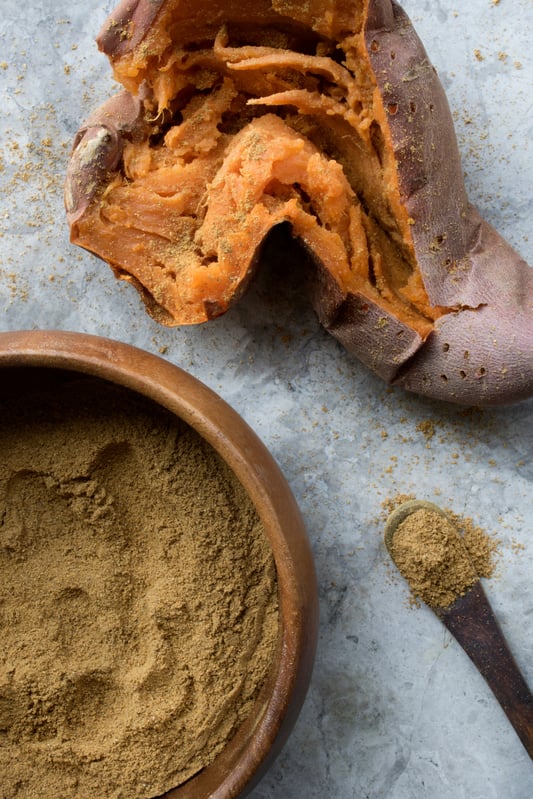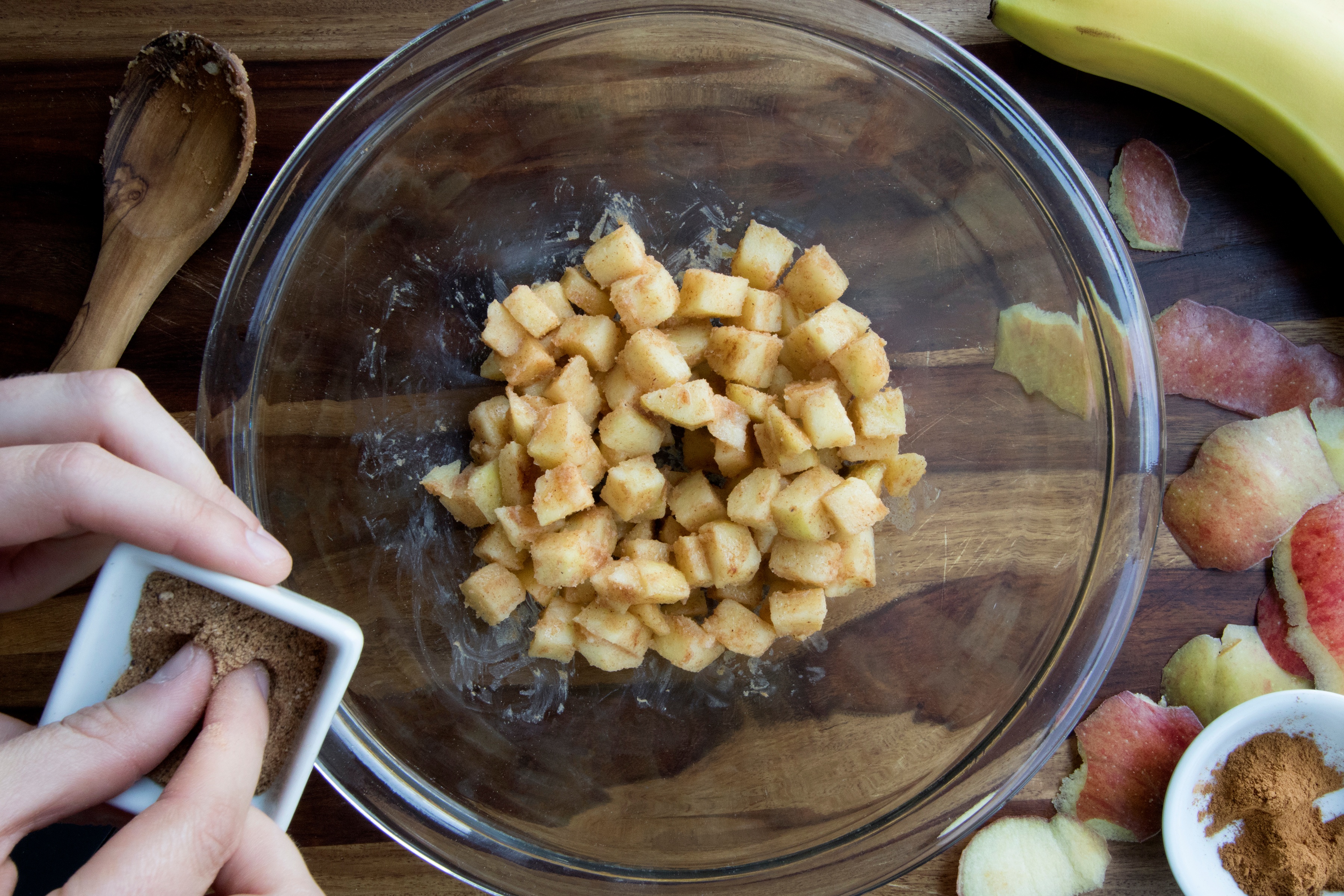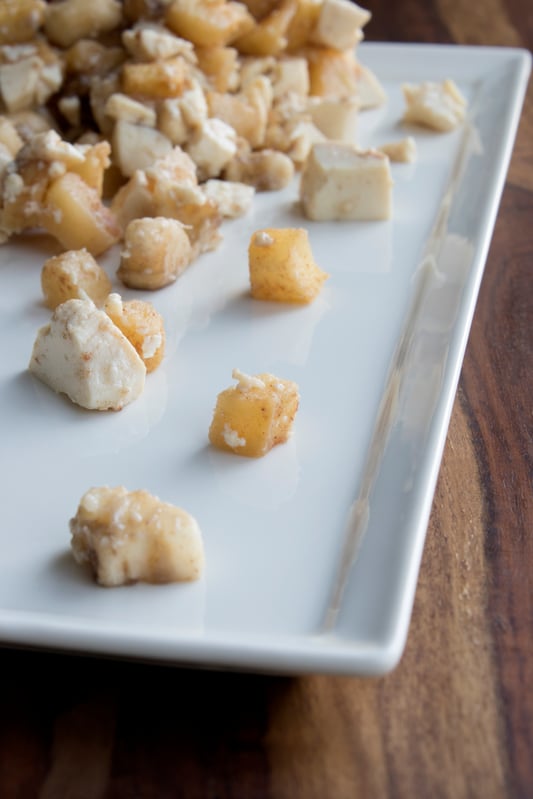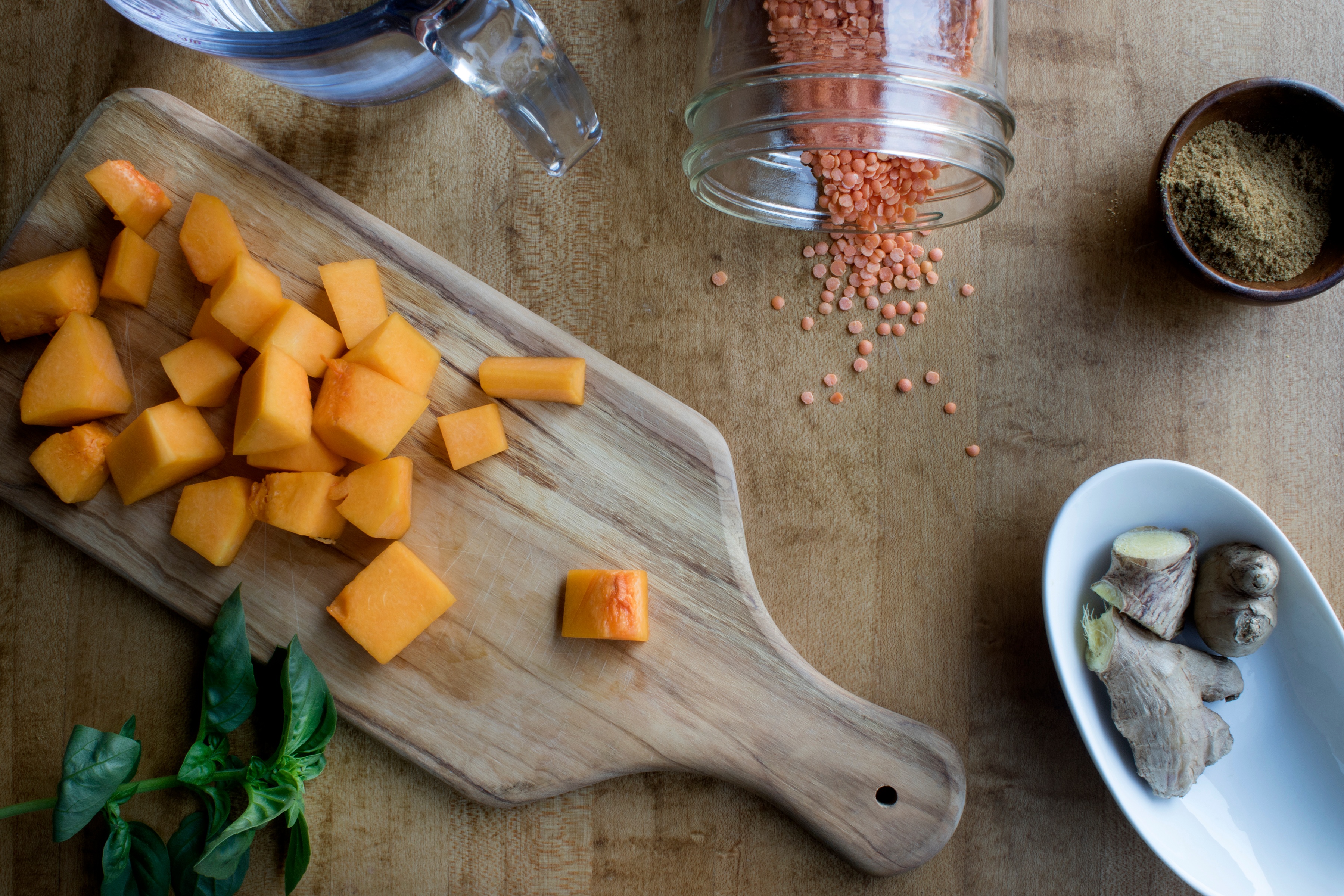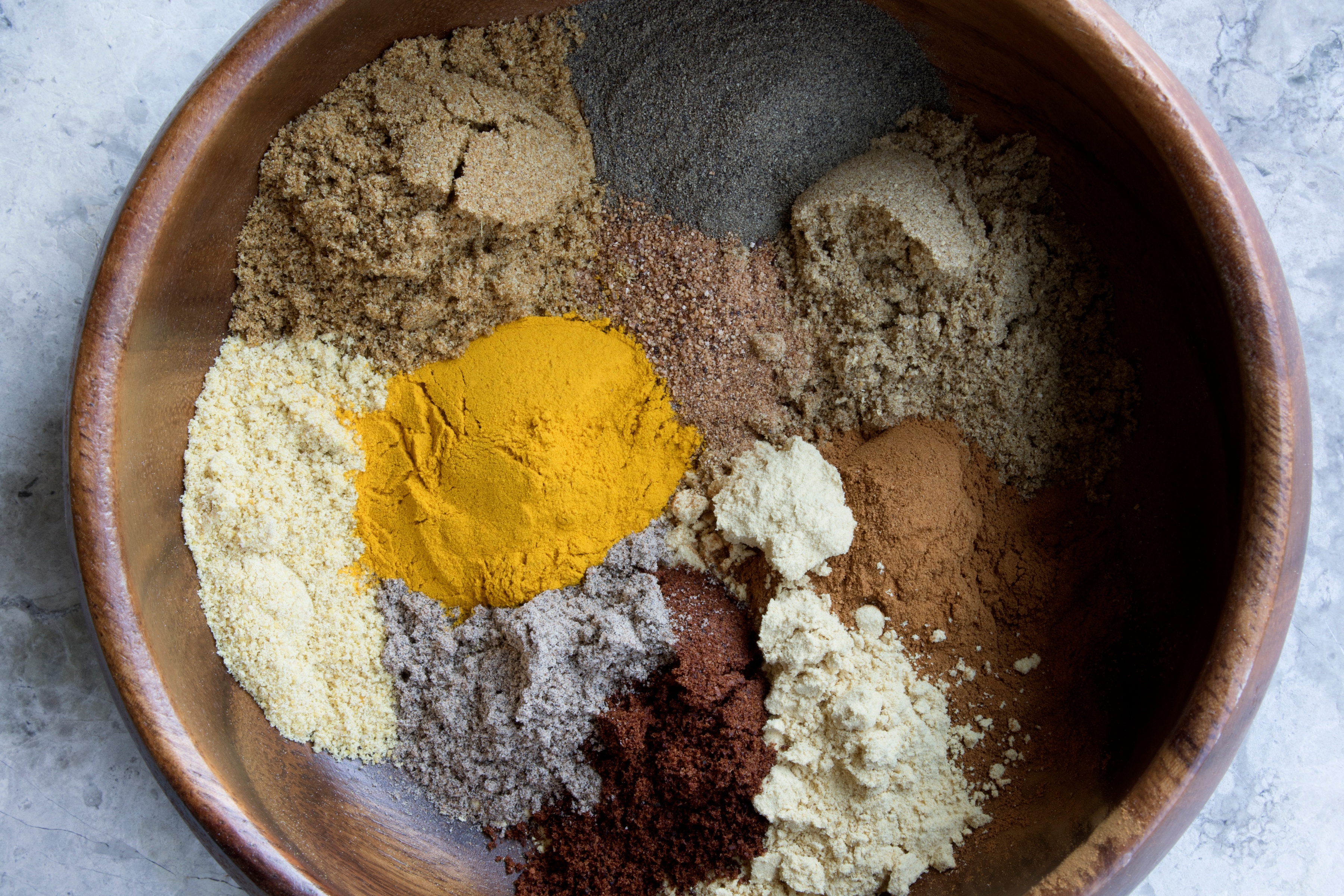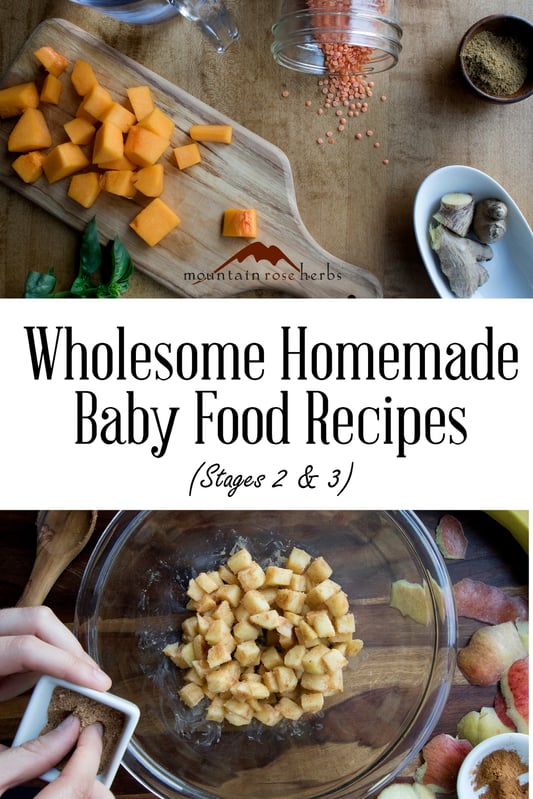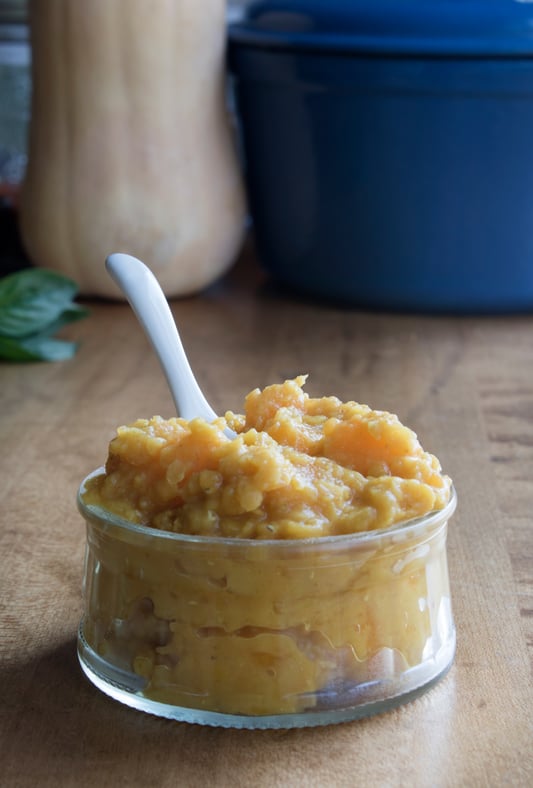
Recently, my husband and I were taking a training class with our puppy, Gracie Cakes. The dog trainer suggested that we class attendees head to the grocery store and buy jars of baby food as training treats for the dogs — apparently, dogs love the common pureed ingredients used in commercial baby foods. I say this to explain how I found myself standing in a baby food aisle for the very first time in my life. I realized, as I stood there not knowing where to even begin, that I had raised three babies to healthy adulthood and, until Gracie Cakes the terrier, had done so without ever twisting the lid from a commercial baby food jar.
There are a myriad ways to conceive and raise healthy, happy babies and a variety of strategies parents may use to manage the transition from breastfeeding or formula to solid foods. Being longtime foodies, my husband and I chose to practice what is now called “baby-led weaning,” which in our house more or less meant that the babies ate what we ate just as soon as they were old enough to do so and primarily fed themselves, rather than being spoon-fed by us.
Now our babies are grown and starting to have babies of their own, and as they’re beginning the process of determining how they want to feed our precious grandchildren, the topic of homemade baby foods has re-entered my mind and kitchen. I’ve particularly been thinking about the transition from basic “Stage 1” baby foods like organic rice cereals, avocado, sweet potatoes, bananas, and applesauce, to foods with more complex flavors and substance.
Adding Herbs and Spices (Flavor!) to the Baby’s Palate
Baby Foods for Stage 1: Keep it Simple
Every baby’s development is different, but until they’re somewhere between four and six months old, their tongues have a “thrust reflex” response that protects them from choking. The tongue automatically protrudes to push things out, rather than swallowing it farther back in the mouth. So although they’re good swallowers and great nursers, they’re lousy at chewing and terrible at getting food from the front of the mouth to the back. Additionally, their digestive tracts aren’t yet able to manage much complexity in their food without upsetting the stomach and bowel tract. As they get closer to six months old, the thrust reflex gradually diminishes, their digestive tract matures and—equally importantly—they hit the stage of development where they start to be able to sit up. At this point, children are usually ready to take on their first semi-solid foods. Note the “semi-” in this statement. First stage baby foods have to be very smooth and thin enough in consistency to easily slip past that inexperienced little tongue. Flavors are simple and foods are low-allergy and very basic.
Baby Foods for Stage 2: Introducing Flavor!
Somewhere between seven and ten months old, most babies are ready for thicker, more textured foods. These “Stage 2” foods can be introduced when the tongue thrust reflex is completely gone and baby is beginning to figure out chewing. Little humans don’t get their molars until they’re over a year old, but they are remarkably effective at mashing soft things between their gums (just ask any nursing mother!). At this same time, their digestive tract is also ready for new experiences. Now they can handle more fibrous food items, higher amounts of protein, more acidic foods, and other culinary firsts, provided they are mashed or pureed and not very complex. Think lentils, berries, egg yolks, potatoes, tofu, and (FINALLY!) a few herbs and spices!
Baby Foods for Stage 3: Spice Is Nice
Babies older than ten months have developed some important skills for further culinary exploration: more advanced swallowing abilities, stronger “chewing” muscles (and perhaps a few teeth to go with them!), and the coordination to (occasionally) transport food into their own mouths. Soft, small chunks of fruit, vegetables, and proteins may now be appropriate, and adding herbs and spices to these solids ups the flavor value so that we don’t need added salt and sugar to make our food enjoyable. Also, opening up your child’s palate when they’re young to a wide variety of flavors helps them be happier, less picky eaters when they’re older.
A good way to begin is to offer your baby lightly spiced versions of foods they’ve already successfully tried and liked. By offering one new flavor at a time, you can then watch for reactions to that herb or spice. If your baby enjoyed it and didn’t experience any digestive upset or allergies over the next three or four days, you can incorporate that flavoring and try another one. If your child shows any signs of stomach upset, diarrhea, or allergic reactions like a rash, it may be too early or the wrong food for your baby, and you’ll be able to isolate the culprit easily.
Herbs & Spices for Babies
Some great baby-friendly seasonings to explore include:
- Allspice
- Basil
- Cardamom
- Cinnamon
- Mild curry powder blend (no “hot” ingredients)
- Dill
- Garlic (fresh minced or roasted, or powdered)
- Ginger
- Lemon zest
- Mint
- Nutmeg
- Orange zest
- Oregano
- Black pepper (used sparingly)
- Rosemary (powder works well for easy swallowing)
- Alcohol-free vanilla (pure vanilla often contains alcohol to extract and preserve the flavor of the bean. Be sure to flavor your baby’s food with vanilla bean or vanilla extract that is alcohol-free).
And here are some baby-tested recipes to investigate with your little eaters. Enjoy!
Stage 2 and Stage 3 Wholesome Baby Food Recipes for Introducing Herbs and Spices
Tofu Bites with Banana & Roasted Spiced Apple
Soy products aren’t easy for young babies to digest, but at around eight to ten months of age, their digestive systems become strong enough to process tofu and love it. Adding tofu chunks to some of their favorite fruits in a form that they can pick up by themselves makes this a favorite meal for the small set. It’s also very portable for midday snacking. This recipe assumes that baby is already comfortable with apples and bananas and has had a successful introduction to plain tofu.
Ingredients
- 1 sweet-tart cooking apple, such as a Pink Lady, Fuji, or Braeburn (about 1/3 lb.)
- 1 tsp. melted organic butter, organic unrefined coconut oil, or organic refined coconut oil
- 1/8 tsp. organic (sweet) cinnamon powder (adjust according to taste)
- 1 pinch organic nutmeg powder (adjust according to taste)
- 4-6 oz. soft organic tofu
- 1 organic banana
Directions
- Preheat oven to 350° F.
- Peel and core the apple and cut it into bite-size pieces (depending on baby’s stage of eating, roasted apples can always be cut smaller or smashed with a fork, so don’t overthink the size at the get-go).
- In a bowl, toss the apple pieces with the melted butter or coconut oil until evenly coated.
- Add the cinnamon and nutmeg and toss again.
- Transfer to a small baking sheet or pan, just large enough to hold the apples in a single layer. The idea here is to capture as much of the roasted apple juice as you can.
- Bake for 10 minutes, remove, stir, and put back in oven.
- Continue baking until apples are fork-tender but not yet falling apart, about 10 to 15 minutes more, depending on the size of your apple chunks. Browned apples are great, but don’t let them get too dark.
- Transfer apples and all their juices to a bowl. Set aside to cool.
- Lightly press the tofu to expel extra liquid, then pat dry.
- Cut tofu into bite-size pieces.
- Cut banana into bite-size pieces.
- Add the tofu and bananas to the cooled apples and gently toss together.
Pro Tips:
- Rather than putting the apples in a pan, you can wrap the pieces in a foil pouch and seal tightly to hold in the juices. This is a particularly useful method when you’re camping; just tuck the foil pouch into the coals of your campfire until you have fork-tender chunks.
- If you have leftovers, throw everything into a blender and blend to a smooth consistency for a delicious makes-baby-happy smoothie. Add more tofu if you need to thicken the consistency.
Red lentils cook faster and are smoother than some other types of lentils, making them a great choice for soups, dips, and baby food. Yellow split peas or other lentil varieties can be substituted here. This recipe assumes baby has already had happy experiences with squash and lentils.
LAU DAL WITH RED LENTILS
Makes enough for multiple meals. Make ahead and freeze in baby-size portions for quick dinners.
Ingredients
- 1 lb. organic butternut or kuri squash
- 1/2 cup organic red lentils
- 1 cup water
- 1 pinch organic turmeric root powder
- 1 organic bay leaf
- 1 tsp. organic cumin seed powder
- 1 Tbsp. minced or finely grated fresh ginger root (peeled)
- 2 Tbsp. fresh organic basil leaves, finely chopped
Directions:
- Peel and cut the squash into 1.5-inch cubes.
- Combine the squash cubes with the lentils, water, turmeric, bay leaf, cumin, and ginger root in a heavy pot.
- Stirring constantly, bring to a boil, lower heat, and simmer for approximately 20 minutes, until the squash is fork-tender and the lentils are very fully cooked and “melting” into the dal.
- Stir finely chopped fresh basil into the hot dal.
- Cut or mash squash as necessary to achieve the right consistency for your baby’s eating stage.
Pro Tip:
- To make this a family meal, chop up half an onion and a jalapeno, and fry separately. Stir into the non-baby portion of the completed dal, along with your favorite natural salt to taste. Serve over rice or with naan.
- As baby’s belly becomes accustomed to onions, add the half a chopped onion to the pot with the squash, lentils, water, and spices, and cook as in recipe above.
Baby-Friendly Curry Powder Blend
In many parts of the world, people start feeding their babies mild curries before they’re a year old, and for good reason. With no “heat,” mild curry blends are full of warm, nourishing goodness. When your baby has successfully incorporated some herbs and spices into their diet, try this very mild curry blend sprinkled on a variety of naturally sweet or savory dishes.
Ingredients
2 tsp. organic turmeric root powder
2 tsp. organic coriander seed powder
2 tsp. organic cumin seed powder
1 tsp. organic (sweet) cinnamon powder
1 tsp. organic ground ginger
3/4 tsp. organic yellow mustard seed powder
3/4 tsp. organic ground white pepper or 1/2 tsp. organic ground black pepper
1/2 tsp. organic cardamom powder
1/2 tsp. organic clove powder
1/2 tsp. organic nutmeg powder
Directions
- Whisk all ingredients together in a bowl or put into a jar, secure lid, and shake to thoroughly combine.
- Store leftover curry blend in a tightly-sealed container in a cool, dark place.
This curry powder blend can be used in a number of ways that will make babies happy:
- Sprinkle on squash or pumpkin and roast in the oven.
- Blanch some spinach, sprinkle with a pinch of curry powder, and mince.
- Sprinkle on garbanzo beans or peas and heat through.
- Stir-fry with tofu and finely chopped vegetables.
- Sprinkle on a soft, sweet fruit like peaches, pineapple, or mango.
- Etcetera! Explore the possibilities with your baby.
Looking for more DIY baby care recipes?
Learn How to Make Your Own Washable Baby Wipes
You might also enjoy:

